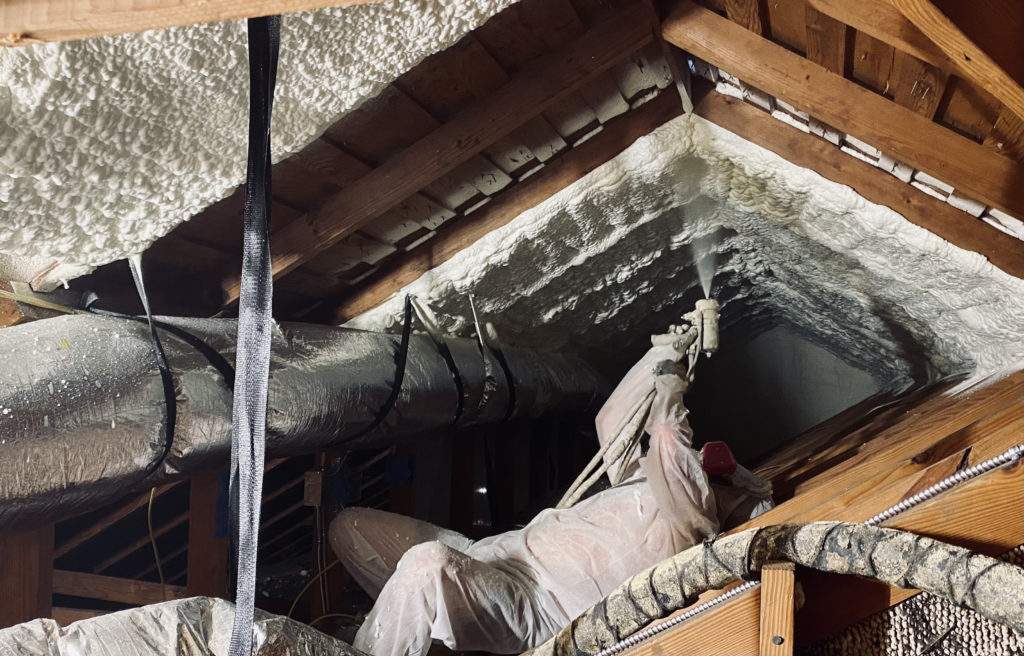
How does a spray foamed roof solve problems?
Creating an encapsulated attic addresses the 4 major heat loads on your home that equate to about 50% of the total heat load.
- Air seals all attic penetrations
- Permanent proper insulation levels
- duct leakage stays in the building envelope
- ducts deliver perfect 55* air in the cooling season (9 months)
What you need to know about transforming your attic!
Technical information for open cell spray foam installs
Stellrr recommends installing R-25 nominal fill of open cell spray foam in attics. Gable walls installed at R-13. This is IECC and COA performance code compliant.
Stellrr installs Huntsman (Icynene) OC No Mix. Icynene is now owned by Huntsman, but the formulation is the same. Icynene was started in Canada where the green building and environmental requirements are much higher than in the USA. Which means Icynene formulations are the lowest VOC, healthiest products to have in the home. It is an ultra-low VOC product allowing for 1 hour job site re-entry and 4 hour job site re-occupancy at applicable ventilation rates.
Comparisons of vented vs. encapsulated attics
What R-Value do you need on your attic roof deck?
Do you need R-49 foam which is the minimum code requirement for blown insulation on the attic floor? You can read about the difference between Prescriptive Code requirements and Performance Code. With foam we are meeting or exceeding the Performance code requirements, so we are doing well at R-25 open cell spray foam on the roof deck.
On Shawn’s personal home, it was built in 2011 by Meritage Homes. Back then, the code requirements were R-20 for the city of Austin. R-20 is just not enough. Shawn was able to take his thermal camera and get significant variances in temperature with the R-20 foam. So he had one of his sprayers add R-5 of Icynene open cell to the existing open cell spray foam insulation. Now the thermal camera registers the entire attic roof as the same temperature.
What is the process? Where do we install insulation?
First the existing insulation is removed. The attic is updated to allow for effective and safe encapsulation. Ensuring bath exhaust fans are ducted outside. Manage any combustion unit make-up air ventilation rooms, build a mesh wall to foam and seal the porches and garage off from the main attic. Next is sterilizing.
Then we install spray foam to the underside of the roof decking. The roof decking is the wood that your shingles are nailed to from the top side. We cover any ridge vents, roof vents, block the soffits, cover the gable end vents, etc. Then we spray the roof, the gable walls, and everything down to the top plate. This seals your attic
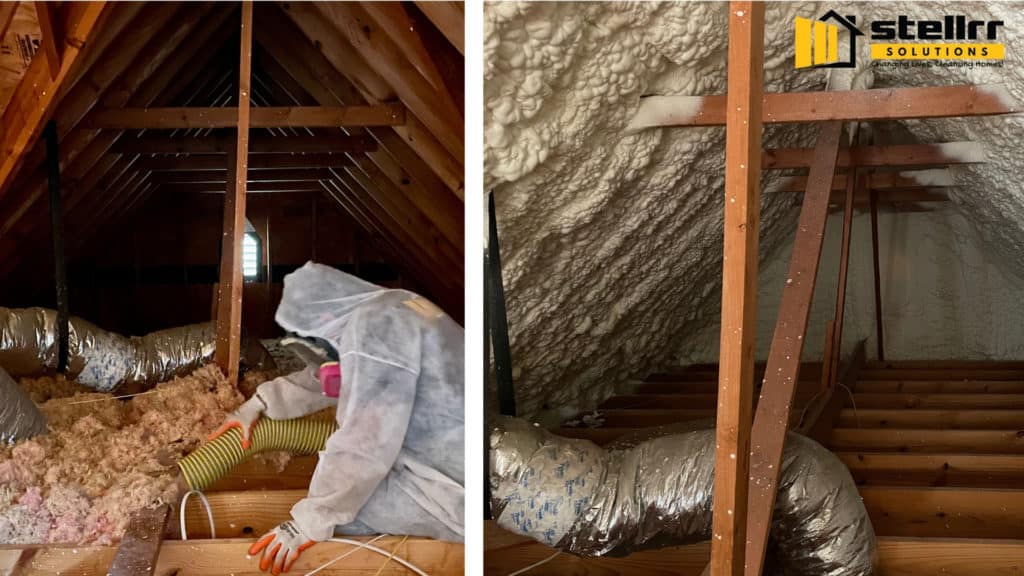
How messy is the removal and installation process?
Anytime insulation is sprayed or blown in there will be a cloud of dust or vapor. We use fans to suck out the stuff in the attic air. However, the inside of the house is separated from the attic with your drywall ceiling. So really nothing should get inside the house other than a slight odor. With that said, we do recommend opening the windows and turning the ceiling fans on to help air out the place.
Plus, when we are done we always recommend having a house cleaner come out and deep clean everything. You just had construction done on your home. No matter how much preparation we do to protect everything, and how good we clean up, there will be something left behind. So it is better just to be safe and get a cleaner you trust to make your upgraded home shine.
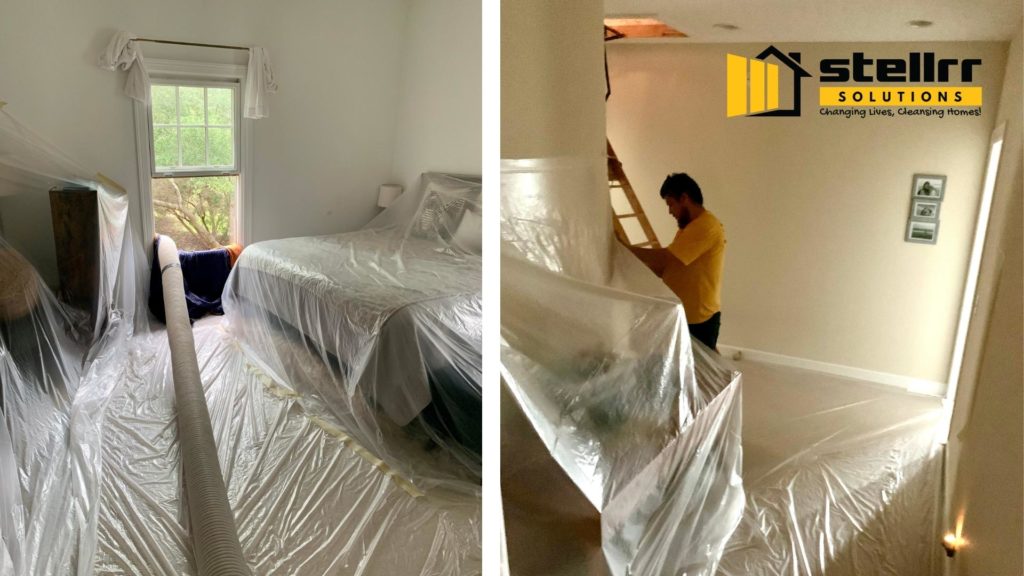
What unique precautions does Stellrr take?
- Block soffit so it doesn’t spray out the soffit onto your siding ruining it.
- Protect the attic access so we don’t mist inside your house.
- Put down protection for your flooring so we don’t leave a trace.
- Block the gable vents, roof vents, ridge vents so foam does not spray onto your roof.
- Build walls to block the house attic off from the porch attic.
- Build walls to block the garage attic off from the house.
- Install sealed access doors to blocked off areas if access is needed.
- Seal down to the top plate on the house perimeter so it fully stops the air leakage.
ADDITIONAL OPTIONS – Separate Line Items
A. Is the Garage & Porch included in the spray foam line item?
We install foam on the underside of the roof deck and gable walls over the conditioned space. We block off the porch and garage. If we are spraying the garage, it will be a seperate line item.
Our quotes are based on the Central Appraisal District footprint of the house, plus roof pitch.
The garage and porches are always a seperate line item on the CAD, and thus if we are insulating them, it is a separate line item there too.
If the house attic is shared with the garage attic, code requires that the house attic be separated from the garage attic even if we are also foaming the garage. Why? They want to prevent any potential vapor from the garage going over into the house. So we build a mesh wall, install a zip door, and then foam the wall to seperate it.
B. What is an ignition or thermal barrier and why?
Spray foam is a plastic based material and therefore has a lower smoke, and ignition point than do other materials like Rockwool (which is fireproof).
According to International Residential Code (IRC), spray foam is to be coated with an ignition or thermal barrier under certain conditions.
The spray polyurethane foam we install is Class 1 Fire rated which is the safest class. Commercial buildings require Class 1 Fire rating on materials.
- What does the IRC code want and where?
- What is qualifies as a thermal or ignition barrier?
- Why didn’t Stellrr’s competitors notify me about this building code?
- Do I have to install an intumescent coating? What happens if I decline it?
- What are the alternatives to an intumescent coating?
- What about Appendix X foam that has some ignition barrier in it? Is that good enough?
- What if I wait to have the ignition barrier installed later?
The above questions are answered on the intumescent coating section here.
C. How are gas / propane utilities handled?
Does your attic has gas or propane combustion utilities like an HVAC or Water Heater (WH) that use your attic for make-up air to feed the combustion? If yes, then we will have a seperate line item for a Combustion Ventilation Closet for how we handle these items to create a sealed envelope while still bringing in the 1-for-1 make-up air exchange.
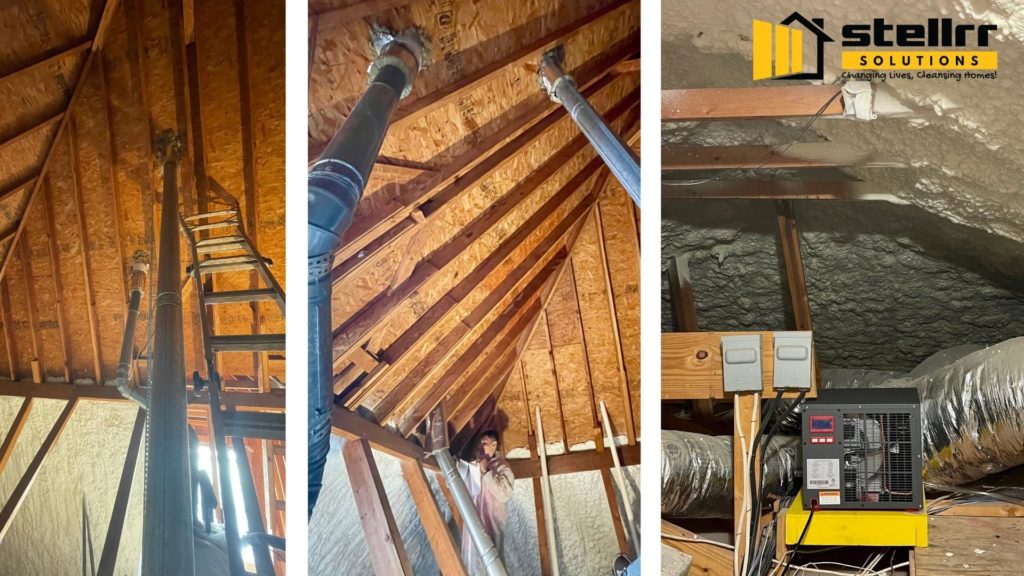



If your HVAC or WH flue pipe through the roof is PVC plastic, that is because it is 95% efficient or greater. It means that the unit brings in combustion air through that PVC pipe, and has an inner layer where it exhausts out fumes.
If you have a metal pipe going out your roof from the WH or HVAC, then you probably have an 80% efficient unit, meaning it requires attic make-up air. So we will have a seperate line item to build out a Combustion Air Closet. The closet will have a zip door on it so that the tech can come in, service the equipment and do any needed work. Then zip it back up upon leaving.
What about when I need to REPLACE my HVAC or WH?
Great! Now you can upgrade to a more efficient and smaller unit. That means that the Combustion Air Closet is no longer needed. It can be demolished in less than 2 minutes with a baseball batt or 10 minutes with a hand saw. Very easy. Now your new unit can go in with zero obstructions.
What if I need WORK done on my HVAC or WH?
Once your attic is converted from blown insulation on the attic floor, to foam on the attic ceiling, it is a workers dream come true.
The problem with blown insulation on the attic floor is it is always in the way of any work needing to be done. Technicians will damage the blown insulation walking through your attic to run wires, fix plumbing, check the HVAC, or Water Heater, etc. The same thing with pests, they scurry through and damage the insulation.
However, a foamed roof is up and out of the way. There is clean and clear access for whatever work a technician needs to do. It is also a cool safe environment for them to work. If you ever have pests enter the attic, you will hear them loud and clear walking on your Sheetrock. Then with a clean, clear attic, you can find them and get rid of them asap.
Growing up, the house I live in had a spray foamed roof. I had access to storage under that was exposed to the foam roof. Never once did I see any of the foam damaged in my childhood home. My parents sold their home a few years ago, 20 years after building it. When we were prepping it for sale, I inspected all of the foam insulation, still no damage. Perfect condition. But can you imagine if it was blown insulation? It would be a disaster.
What about roof leaks, repairs, or replacements?
My childhood home, mentioned in the paragraphs above, had the roof replaced just before my parents sold it. The house was 20 years old and had been foamed. Of the entire house, there was part of a sheet of decking that needed replacing. The decking was in a valley and had some rot. It came up without damaging the foam, and was replaced. Easy.
I’ve asked several of my roofing friends about their real world experience here. They say that open cell foamed roof DO allow them to find leaks. Open cell is porous and allows moisture to come through close to the leak location.
They say that only 3-5% of roofs need any decking replaced, and at that, it is usually only a sheet of decking regardless if it is a foamed or blown in roof.
If you have to have your roof replaced, it will probably be done with insurance money. So if any foam has to be repaired or replaced, the insurance will cover that as well. But guess how many calls or jobs we have done to repair foam after a roof replacement? We did one job years ago. And it was not because the foam needed repairing. The foam was attached directly to the metal roof. The metal roof was damaged when their carport was blown onto the roof and dented it badly. The roof was able to be removed without damaging the closed cell foam. The building owner wanted to replace the foam because he didn’t like the job my competitor did, and he wanted it to look pretty. So he hired us to re-do the foam 100% since it was a metal building with exposed foam.
Why do shingle manufacturers dislike foam?
Check out my video on Fiberglass and Owens Corning. OC sells shingles. OC sells pink fiberglass. They do not want you to buy other products. They want the builder to buy their entire product line. And they trash foam.
The truth about foam is that it does raise the shingle temperature about 5 degrees. But that is it. If shingles cannot handle 5 degrees more heat than we get in Austin, then they better not sell shingles in other parts of the country where it is 5 degrees warmer than Austin.
Further, if the foam is “bad” for shingles, why is the owner of the Klaus Roofing franchise network spray-foaming the underside of his roof? I was recently visiting with Klaus Larson at an event and posed this same question to him. He agreed with my statements and shared that the roof on his new, very large home was being foamed as Stellrr does daily.
I foresee that this misinformation that has been spread since the 1980s will begin to change. Why is that? Owens Corning and Johns Manville (the 2 behemoths in roofing) just bought into the foam manufacturing business. I wonder if the old marketing department that trashed foam is still employed?
Doesn’t my house need to breath?
Seal it Tight. Ventilate it Right. A leaky house is not healthy for you or the house. A sealed house without mechanical ventilation can be troublesome as well. So the answer is to seal it tight so that you can control everything. Then set up the mechanical ventilation so that only “breathes” as much as is necessary.
So what happens if you spray foam my attic, converting it from a vented to a encapsulated attic? Will it be too tight?
No. You will still have leaky walls & windows and bottom plates, and doors opening. This is sufficient. However, you can upgrade your mechanical ventilation, so that you introduce a certain amount of air into your house at set intervals daily. If we are building a combustion closet for you, we are still bringing in fresh (make up) air into that closet, so fresh air will be introduced. But you can also have what is called an Energy Recovery Ventilator (ERV). ERVs are a luxury, and rarely installed even in new custom build homes.
Your tight house will now allow you to manage the humidity inside the house. One way of managing the humidity is through our SaniDry dehumidifier system.
Do I need a dehumidifier installed in an efficient home?
Let’s talk more about moisture in the air. Austin is a very humid environment, often 80-90% humidity. This creates a great environment for all sorts of things to grow. If we are constantly bringing in humid air from outside, then we are creating a not so healthy environment inside. We need to seal up the house air leaks not only for energy savings & comfort. But we need to seal up the house for our health. Then we can manage the humidity more effectively. And we can stop mold growth, wood rot, and protect the house structurally.
Do you need a dehumidifier? If your house is sealed up properly, your HVAC unit will pull the humidity out of the air effectively in the summer, while avoiding bringing in excess outside humidity. But, in the cool part of the year, if your house is efficient, you won’t be running your HVAC enough to pull the humidity out of the air.
In Austin, it is a good practice to have a self-draining dehumidifier like SaniDry installed either in your crawlspace or attic.
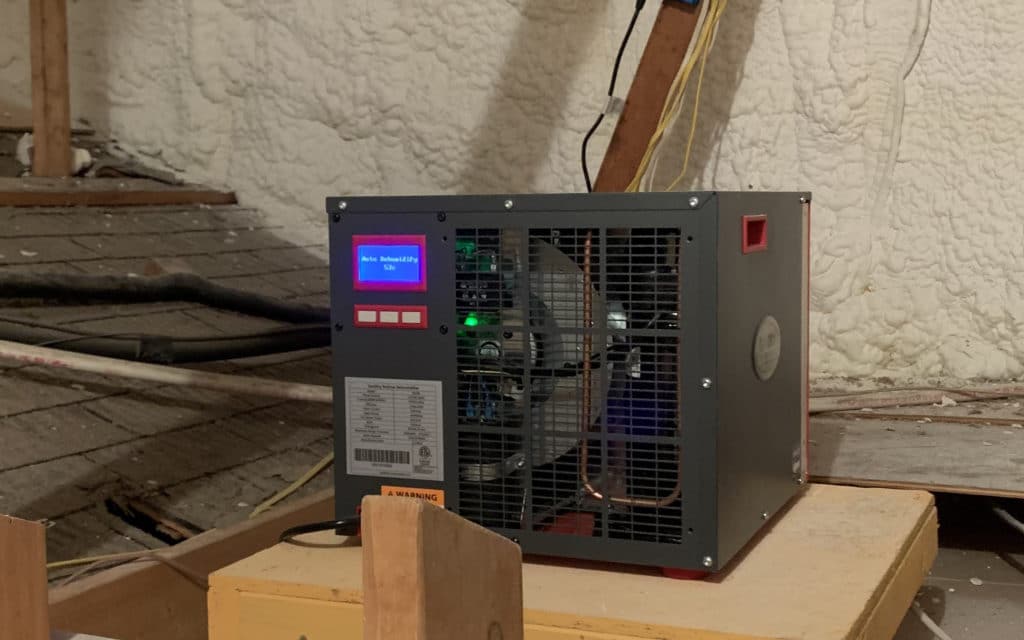
We recommend that every house have a SaniDry dehumidifier installed. SaniDry is always a separate line item. Learn more about having a SaniDry installed in your attic.
Who am I and why am I sharing this?
My name is Shawn Mansur, I’m the founder of Stellrr. Stellrr started as an insulation contractor, like the rest of them. We had a lot of Remodeling Contractors & Home Inspectors who advised their homeowners on adding fiberglass insulation on the attic floor.
Stellrr did a lot of work for these companies. Little did I know we were doing almost nothing to fix the problem.
Over the years, we found out that the problems rarely went away. Adding blown insulation to a leaky building didn’t give much if any result and never solved the comfort or energy savings problems.
My mission is to change lives and I was failing.
I was frustrated and felt hopeless until one day I was introduced to my friend Larry Janesky. He taught me a lot of building science and helped me realize what homes needed was to be cleansed. Once we started cleansing homes we started getting dramatic results. Life changing results for our clients.
Stellrr almost completely stopped working as a sub-contractor for companies. Now we accept referrals from Contractors and Inspectors so that we can diagnose and prescribe the correct solution for the homeowner. This allows us to ensure great results.
Here is what to do next.
Approve the Project and the Pay Deposit. Or request a change to the estimate your received from your Solutions Specialist.
Don’t make the mistake I did. Let’s create a safe and healthy indoor environment for you and your family.
Changing Lives, Cleansing Homes. Stellrr
